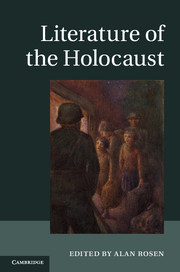Book contents
- Frontmatter
- Contents
- Notes on contributors
- Acknowledgments
- Introduction
- Part I Wartime victim writing
- Part II Postwar responses
- Chapter 3 The Holocaust and Italian literature
- Chapter 4 German literature and the Holocaust
- Chapter 5 Hebrew literature of the Holocaust
- Chapter 6 The Holocaust and postwar Yiddish literature
- Chapter 7 The Holocaust in Russian literature
- Chapter 8 The Holocaust in English-language literatures
- Chapter 9 Polish literature on the Holocaust
- Chapter 10 Hungarian Holocaust literature
- Chapter 11 French literature and the Holocaust
- Part III Other approaches
- Guide to further reading
- Index
- References
Chapter 11 - French literature and the Holocaust
Published online by Cambridge University Press: 05 June 2014
- Frontmatter
- Contents
- Notes on contributors
- Acknowledgments
- Introduction
- Part I Wartime victim writing
- Part II Postwar responses
- Chapter 3 The Holocaust and Italian literature
- Chapter 4 German literature and the Holocaust
- Chapter 5 Hebrew literature of the Holocaust
- Chapter 6 The Holocaust and postwar Yiddish literature
- Chapter 7 The Holocaust in Russian literature
- Chapter 8 The Holocaust in English-language literatures
- Chapter 9 Polish literature on the Holocaust
- Chapter 10 Hungarian Holocaust literature
- Chapter 11 French literature and the Holocaust
- Part III Other approaches
- Guide to further reading
- Index
- References
Summary
One’s initial uneasiness in pairing the categories of French literature and the Holocaust relates to the fact that an exaggerated appreciation of the affinities between them, the spurious notion that the Holocaust may always already have been contaminated by fiction, is a principal plank of Holocaust denial, one that has enjoyed a measure of notoriety in France and in particular on the French far left. That notion was sufficiently current in the France of the 1980s for the eminent Hellenist and public intellectual Pierre Vidal-Naquet to feel obliged to address it, while refusing to dignify it with a refutation, in a somewhat disheveled volume, Assassins of Memory, in 1987, and for the philosopher Jean-François Lyotard to deal with it as the prime illustration of the kind of language game he analyzed under the rubric of Le Différend. Finally, the “negationist” fever, although sporadically fueled by rising anti-Zionism in Europe, subsided in the wake of Alain Finkielkraut’s demonstration of just what a godsend the thesis denying the gas chambers was for a far left eager to efface the differences between fascism and any other mode of capitalism. If there were no gas chambers, the argument went, there could be no basis for the left to side with anti-fascist liberalism against a fascism in no essential way different from it. Exit the phenomenon of Holocaust denial as a movement with any claim to plausibility.
- Type
- Chapter
- Information
- Literature of the Holocaust , pp. 174 - 190Publisher: Cambridge University PressPrint publication year: 2013
References
- 1
- Cited by



